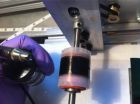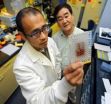(Press-News.org) An experiment carried out on rodents exposed to fuel similar to that of the Prestige tanker oil spill – which took place nearly a decade ago – shows that inhalation of the fuel causes damage to genetic material. According to the study, led by the University of A Coruña, the results could be used in relation to people who carry out the industrial cleaning of coasts.
On 19 November, it will be ten years since the sinking of the Prestige, which caused one of Spain's largest ecological disasters. The oil spill reached the coasts of Galicia and the rest of the Cantabrian coast, right up to the Landes area of France and Portugal. Thousands of people aided in the cleaning of the contaminated beaches and were exposed to the fuel for prolonged periods.
In order to confirm the effects of such exposure on the health of human beings in this and other circumstances, a team of researchers from the University of A Coruña carried out an experiment using two different strains of rat and a respiratory chamber especially designed to create fuel exposure. For two hours a day, five days a week, the animals were exposed to a fuel similar in composition to that of the Prestige oil spill. This study has now been published in the Journal of Toxicology and Environmental Health.
"Induced damage to genetic material and the development of different respiratory ailments has been previously been seen in people who took part in the oil spill cleanup effort," Vanessa Valdiglesias, researcher at the Toxicology Unit of the University of A Coruña, explains to SINC. The former institution, along with the Institute of Biomedical Research of A Coruña, has already tried to describe the effects of the oil spill on people's health.
"Nevertheless," continues Valdiglesias, "in these studies, the environmental exposure measures were scarce or nonexistent, which made it difficult to attribute the observed effects directly to fuel exposure."
The new study of rats shows a direct link between respiratory exposure to compounds discharged by the fuel and damage to genetic material. In order to analyse the possible alterations to the DNA and its repair processes, the researchers took blood samples from each animal and carried out cytogenic tests.
The results were clear: exposure to fuel through inhalation causes damage to the DNA of both types of rat – both of which differed in susceptibility to the compounds of the fuel – and also alters DNA repair processes.
The research group evaluated the damage to the DNA on a global scale, and more specifically looked at oxidative damage, with the aim of guiding decisions regarding diagnosis and therapy in the care of those affected by fuel exposure, whatever the circumstances. "This involves those professionals carrying out their occupational duty in extraction wells, refineries, petrol stations etc, as well as those who aid the cleanup efforts following oil spills," the main author explains.
Valdiglesias proposes to inform people properly of the health risk which such exposure carries. "I believe coordination and general organisation of cleanup activities in affected zones is also relevant," she continues.
In her opinion, however, the most important thing is to follow the instructions given by the professionals when it comes to the protective gear which should be worn in each case – such as the use of masks, gloves and overalls – and the correct way of wearing these items.
It must be borne in mind that certain higher risk groups, such as children, pregnant women and those suffering from cardiorespiratory illnesses "should avoid exposure to fuel as much as possible," Valdiglesias concludes.
INFORMATION:
References:
Valdiglesias, Vanessa; Kilic, Gözde; Costa, Carla; Amor-Carro, Oscar; Mariñas-Pardo, Luis; Ramos-Barbón, David; Méndez, Josefina; Pásaro, Eduardo; Laffon, Blanca. "In vivo genotoxicity assessment in rats exposed to Prestige-like oil by inhalation" Journal of Toxicology and Environmental Health-part A-current issues 75. Pages: 756-764 DOI: 10.1080/15287394.2012.689801, 2012.
Exposure to 'Prestige' fuel causes short-term damage to rat DNA
2012-10-15
ELSE PRESS RELEASES FROM THIS DATE:
Replicating risk genes in bipolar disorder
2012-10-15
Philadelphia, PA, October 15, 2012 – One of the biggest challenges in psychiatric genetics has been to replicate findings across large studies.
Scientists at King's College London, Institute of Psychiatry have now performed one of the largest ever genetic replication studies of bipolar affective disorder, with 28,000 subjects recruited from 36 different research centers. Their findings provide compelling evidence that the chromosome 3p21.1 locus contains a common genetic risk for bipolar disorder, the PBRM1 gene.
The locus at 3p21.1 has also been previously associated ...
Soccer scores a health hat trick for hypertensive men
2012-10-15
Playing soccer (football) could be the best way for people with high blood pressure, known as hypertension, to improve their fitness, normalise their blood pressure and reduce their risk of stroke. Research from Universities of Exeter and Copenhagen, and Gentofte University Hospital in Denmark, published today (Monday 15 October 2012) in the journal Medicine and Science in Sports and Exercise, suggests that soccer training prevents cardiovascular disease in middle-aged men with hypertension and is more effective than healthy lifestyle advice currently prescribed by GPs.
After ...
Programs for treating addiction in doctors pose ethical issues
2012-10-15
Philadelphia, Pa. (October 15, 2012) – State physician health programs (PHPs) play a key role in helping doctors with substance abuse problems. But the current PHP system is inconsistent and prone to potential conflicts of interest and ethical issues, according to a review available as publish ahead of print content from the December 2012 issue of Journal of Addiction Medicine, the official journal of the American Society of Addiction Medicine. The journal is published by Lippincott Williams & Wilkins, a part ofWolters Kluwer Health.
In the article, Drs J. Wesley Boyd ...
'Treasure trove' of film records unlocks history of British Cinema
2012-10-15
A film historian at Queen Mary, University of London has been uncovering the secret past of British cinema in a private collection of production records for thousands of films, including such iconic titles as Dr No, The African Queen, and Zulu.
The unique production archive is owned by Film Finances Ltd, underwriters of many major British films made since the 1950s. The company has kept complete documentation for
every production it has guaranteed, including letters, telegrams, shooting schedules, scripts, storyboards and even doctors' certificates.
In 2009, Film Finances ...
New techniques stretch carbon nanotubes, make stronger composites
2012-10-15
Researchers from North Carolina State University have developed new techniques for stretching carbon nanotubes (CNT) and using them to create carbon composites that can be used as stronger, lighter materials in everything from airplanes to bicycles.
By stretching the CNT material before incorporating it into a composite for use in finished products, the researchers straighten the CNTs in the material, which significantly improves its tensile strength – and enhances the stiffness of the composite material and its electrical and thermal conductivity.
State-of-the-art ...
Aggregation of proteins in cells may result in diseases
2012-10-15
Many diseases are caused by proteins losing their natural three-dimensional structure and thus their function. In most cases, the damaged proteins are degraded by different systems in the cells, but in some cases, the proteins begin to aggregate and form very well-organised rope-like structures called fibrils. These structures have now been linked to many different diseases, such as Alzheimer's, Parkinson's, type 2 diabetes and corneal dystrophies (opaqueness in the cornea).
It has long been known that corneal dystrophy is caused by a mutation of a protein called TGFBIp ...
The Romans used Greek myths in their mosaics as symbols of civilization
2012-10-15
This press release is available in Spanish.This line of research, coordinated by Luz Neira, who is a professor in the Department of Humanities: History, Geography and Art, as well as a researcher in UC3M's Institute for Culture and Technology (Instituto de Cultura y Tecnología), continues on the path established by previous studies that examined the images of women and certain legends in Roman mosaics. "We had previously shown the memory and conscious, self-interested reuse of myths, but this new volume also examines the possibility that there is a subliminal message regarding ...
Protein could be key for drugs that promote bone growth
2012-10-15
AUGUSTA, Ga. – Georgia Health Sciences University researchers have developed a mouse that errs on the side of making bone rather than fat, which could eventually lead to better drugs to treat inflammatory diseases such as rheumatoid arthritis.
Drugs commonly used to treat those types of conditions – called glucocorticoids – work by turning down the body's anti-inflammatory response, but simultaneously turn on other pathways that lead to bone loss. The result can lead to osteoporosis and an accumulation of marrow fat, says Dr. Xingming Shi, bone biologist at the GHSU ...
Antibiotic contamination a threat to humans and the environment
2012-10-15
Researchers from the University of Gothenburg, Sweden, spend August in Sisimiut on the west coast of Greenland studying the prevalence of antibiotic resistance and the effects of antibiotic emissions on communities of bacteria living in marine sediments. More specifically, they were investigating how communities of bacteria in sediment and clay on the seabed are affected by exposure to antibiotics.
"We know very little about what happens to antibiotics that end up in the ocean, but several substances can accumulate in sediments where biodegradation occurs extremely slowly," ...
U-M, other universities launch Great Lakes protection project
2012-10-15
ANN ARBOR—The University of Michigan and 20 other U.S. and Canadian universities will join forces to propose a set of long-term research and policy priorities to help protect and restore the Great Lakes and to train the next generation of scientists, attorneys, planners and policy specialists who will study them.
The Great Lakes Futures Project of the Transborder Research University Network will use a cross-disciplinary, cross-sector approach to outlining alternative Great Lakes futures through science-based scenario analysis.
"With the recent release of the revised ...



